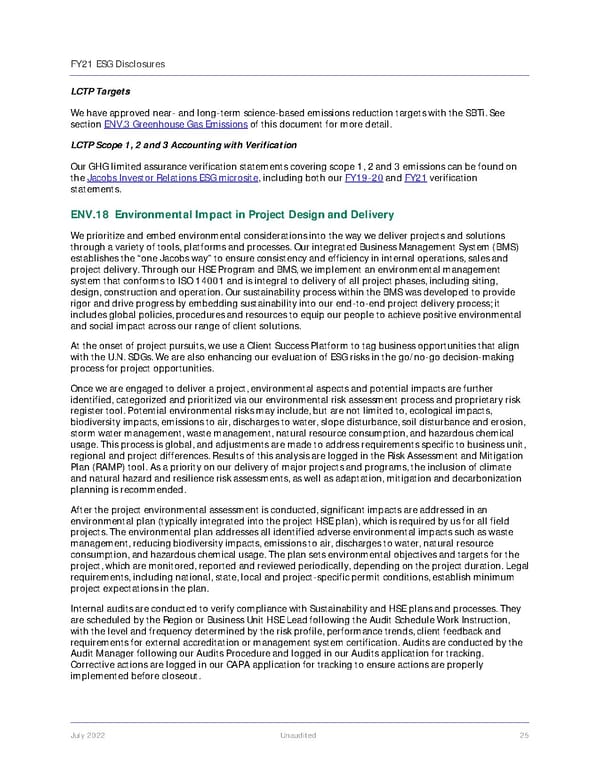FY21 ESG Disclosures July 2022 Unaudited 25 LCTP Targets We have approved near- and long-term science-based emissions reduction targets with the SBTi. See section ENV.3 Greenhouse Gas Emissions of this document for more detail. LCTP Scope 1, 2 and 3 Accounting with Verification Our GHG limited assurance verification statements covering scope 1, 2 and 3 emissions can be found on the Jacobs Investor Relations ESG microsite , including both our FY19-20 and FY21 verification statements. ENV.18 Environmental Impact in Project Design and Delivery We prioritize and embed environmental considerations into the way we deliver projects and solutions through a variety of tools, platforms and processes. Our integrated Business Management System (BMS) establishes the “one Jacobs way” to ensure consistency and efficiency in internal operations, sales and project delivery. Through our HSE Program and BMS, we implement an environmental management system that conforms to ISO 14001 and is integral to delivery of all project phases, including siting, design, construction and operation. Our sustainability process within the BMS was developed to provide rigor and drive progress by embedding sustainability into our end-to-end project delivery process; it includes global policies, procedures and resources to equip our people to achieve positive environmental and social impact across our range of client solutions. At the onset of project pursuits, we use a Client Success Platform to tag business opportunities that align with the U.N. SDGs. We are also enhancing our evaluation of ESG risks in the go/no-go decision-making process for project opportunities. Once we are engaged to deliver a project, environmental aspects and potential impacts are further identified, categorized and prioritized via our environmental risk assessment process and proprietary risk register tool. Potential environmental risks may include, but are not limited to, ecological impacts, biodiversity impacts, emissions to air, discharges to water, slope disturbance, soil disturbance and erosion, storm water management, waste management, natural resource consumption, and hazardous chemical usage. This process is global, and adjustments are made to address requirements specific to business unit, regional and project differences. Results of this analysis are logged in the Risk Assessment and Mitigation Plan (RAMP) tool. As a priority on our delivery of major projects and programs, the inclusion of climate and natural hazard and resilience risk assessments, as well as adaptation, mitigation and decarbonization planning is recommended. After the project environmental assessment is conducted, significant impacts are addressed in an environmental plan (typically integrated into the project HSE plan), which is required by us for all field projects. The environmental plan addresses all identified adverse environmental impacts such as waste management, reducing biodiversity impacts, emissions to air, discharges to water, natural resource consumption, and hazardous chemical usage. The plan sets environmental objectives and targets for the project, which are monitored, reported and reviewed periodically, depending on the project duration. Legal requirements, including national, state, local and project-specific permit conditions, establish minimum project expectations in the plan. Internal audits are conducted to verify compliance with Sustainability and HSE plans and processes. They are scheduled by the Region or Business Unit HSE Lead following the Audit Schedule Work Instruction, with the level and frequency determined by the risk profile, performance trends, client feedback and requirements for external accreditation or management system certification. Audits are conducted by the Audit Manager following our Audits Procedure and logged in our Audits application for tracking. Corrective actions are logged in our CAPA application for tracking to ensure actions are properly implemented before closeout.
 Jacobs Engineering Group ESG Disclosures Page 25 Page 27
Jacobs Engineering Group ESG Disclosures Page 25 Page 27